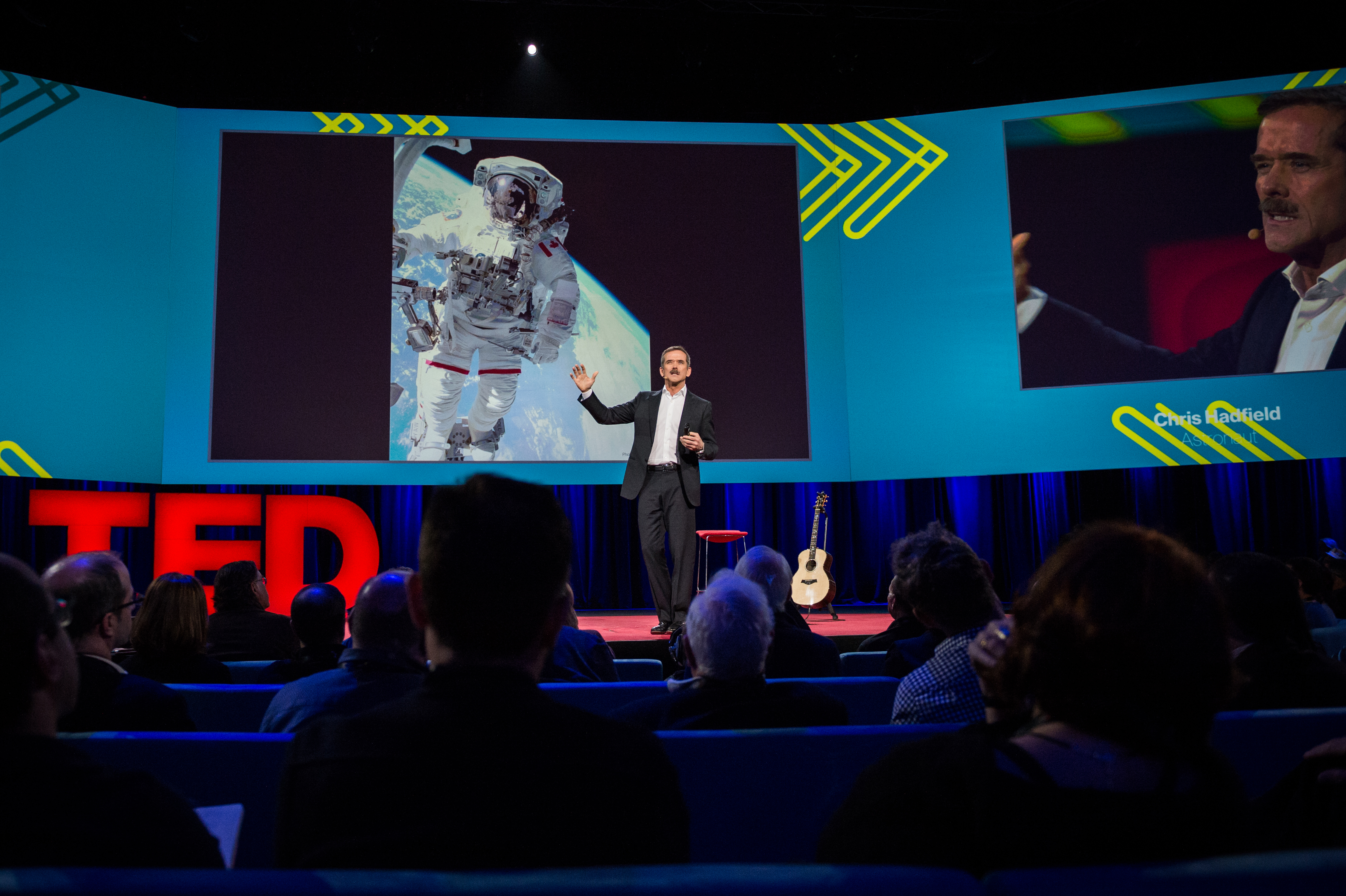Or, asks retired colonel Chris Hadfield to the crowd at TED2014, “What’s the most dangerous? And, why did you do it?” For Hadfield, an astronaut with the Canadian Space Agency and a commander of the International Space Station for 3 months, it was to ride a rocket ship into orbit.
Watch Chris Hadfield’s TED Talk >>
In the early days of shuttle launches, the risk of catastrophic event — that is, death — was 1 in 9. Now it’s 1 in 38. “So it’s a really interesting day when you wake up at the Kennedy Space Center,” about to head to space, “because you realize that at the end of the day you’re either going to be floating effortlessly, gloriously in space, or you’ll be dead.”
The day starts with suiting up and then driving to the launch pad. And as they drive to the center, “in the distance, lit by huge xenon lights, is your spaceship. The vehicle that is going to take you off the planet.” And then each astronaut crawls up into the space ship. And at that moment, “What has been a lifetime of dreams and denial has become real.”
But there is so much that can go wrong, and so much responsibility. The shuttle is one of the most complicated things ever built, and according to the standard astronaut saying, “There is no problem so bad that you can’t make it worse.” And then, the rocket launches, shaking from the liquid oxygen engines, accelerating as if you were sitting in a drag racer with the pedal on the floor, crushing the astronauts and still shaking all the while. And finally after eight minutes and forty seconds, the engines stop. And then, “We’re at exactly the right speed at exactly the right altitude. And we’re weightless. And we’re alive.”
Why would you do this?
Hadfield did it because he was inspired. “I watched the first people walk on the moon, and to me it was obvious: I want to turn myself into that.” He wanted to be someone who wasn’t afraid to take those risks. He wanted to be a part of that project, one that let him see a constant stream of wonders from his window, and take part in experiments to determine what the universe is made of. He wanted to be in a place where he could see “the jaw-dropping gorgeousness of the turning orb, the self-propelled art gallery.”
The best experience up there, says Hadfield, is to do a space walk, to be alone in the universe. Wearing nothing but a spacesuit, which is really just a one-person space ship, “You’re not looking up at the universe; you and the Earth are going through the universe hand in hand.”
But on his very first space walk, he went blind. A blob of material floated into his left eye, provoking a flood of tears, and in space, your tears don’t fall — they just form a bigger and bigger blob of liquid. His vision obscured, he kept going. Until the blob got big enough to split into two and fall into his other eye. He’s blind. In space.
“So,” he says, “What’s the scariest thing you’ve ever done,” and the audience laughs at themselves.
“What are you afraid of?” asks Hadfield. “Spiders? A brown recluse?” That is one of the most venomous spiders in the world, which can kill horribly. But it turns out there’s only one venomous spider in Vancouver, the black widow. And it isn’t fatal, and it mostly hides, uninterested in humans. So what do you do if you’re afraid of a spider? Walk into the next spiderweb you see. “Take a good look and make sure it’s not a black widow, and walk into it. Then do it again. I guarantee if you walk into 100 spiderwebs, you will have changed your fundamental human behavior…. And you can apply this to anything.”
Blind in space
So what do you do in space if you’re blinded? Hadfield, like all astronauts, had trained and trained and trained, not just for the mission going right, but for all the ways the mission could go wrong. He wasn’t out there alone, and he and his spacewalk partner had practiced incapacitated crew rescue, so he knew whatever happened, they could deal with it. After a while, as it turned out, he cried enough to clear whatever had been blocking his vision — which turned out to be the anti-fog used to keep the helmet visors clear.
The last scary part was going home in the Soyuz: “It’s like riding a meteorite home.” But again, starting 20 years ago Hadfield had started studying orbital mechanics, in Russian. Indeed, “We had studied so much we weren’t screaming, we were laughing. It was fun.”
The final lesson was simple and powerful: “You can now look back at what was an incredible experience. You have taken the dreams of that 9-year-old boy that were impossible and dauntingly scary, and put them into practice, and figured out a way to reprogram yourself, to change your primal fear, to allow you to come back with a set of experiences … that could never have been possible otherwise.”
Hadfield finishes the talk by singing his cover of David Bowie’s “Space Oddity.” His time in space makes us all hear the song afresh.
Also watch, Hadfield and the Barenaked Ladies singing “I.S.S. (Is Somebody Singing),” >>
Read Hadfield’s book, An Astronaut’s Guide to Life on Earth >>

Comments (3)
Pingback: Friday Favourites – // Niko & Nonnie //
Pingback: Top 5 Talks at TED 2014 in Vancouver | Vancouver Homes
Pingback: Futureseek Daily Link Review; 19 March 2014 | Futureseek Link Digest